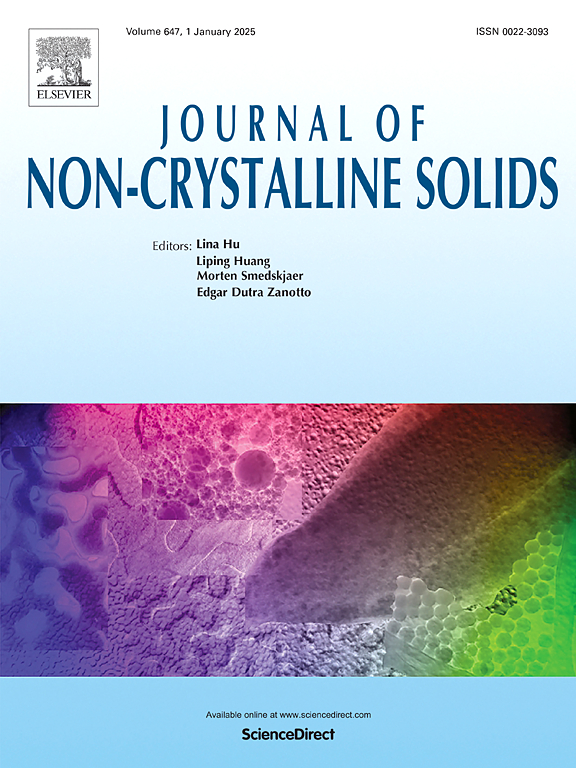研究氧化锌-B2O3-二氧化硅玻璃及其在连接氮化铝陶瓷中的应用
IF 3.2
3区 材料科学
Q1 MATERIALS SCIENCE, CERAMICS
引用次数: 0
摘要
在本文中,我们设计了两个系列的 ZnO-B2O3-SiO2 (ZBS) 玻璃,以探索它们在连接 AlN 陶瓷方面的适用性。系统研究了不同 ZnO 和 B2O3 含量的 ZBS 玻璃的密度、抗弯强度、结构、特征温度、热膨胀系数 (CTE) 和结晶行为。结果表明,随着 B2O3 含量的增加,玻璃网络被打乱,从三维架状结构 [BO4] 过渡到二维层状结构 [BO3],断裂键的数量增加,而 ZnO 含量的增加则使玻璃网络结构更加紧凑。我们还发现,随着 B2O3 和 ZnO 含量的增加,玻璃化转变温度(Tg)和软化温度(TS)都呈下降趋势。除 60ZnO-30B2O3-10SiO2(简称 B30)外,所有样品在热处理后都开始析出 Zn2SiO4 和 ZnAl2O4,其中 Zn2SiO4 未出现衍射峰,而 Zn4B6O13 出现了衍射峰。值得注意的是,Zn2SiO4 是大多数样品的主相,而 B30 样品的主相是 ZnAl2O4。随着 B2O3 和 ZnO 含量的增加,CTE 分别从 4.6 增加到 5.03(×10-6/℃)和 4.23 增加到 4.73(×10-6/℃)。其中,B30 样品的 CTE 与 AlN 陶瓷基底的 CTE 相符。B30 样品在 750 °C 时达到了最佳剪切强度(60.32±10.26 MPa)。高强度归功于界面反应导致的强化学键以及 ZnAl2O4 在夹层中的均匀分布,这增强了夹层本身的强度。本文章由计算机程序翻译,如有差异,请以英文原文为准。
Investigation of ZnO-B2O3-SiO2 glass and its application for joining AlN ceramic
In this paper, we designed two series of the ZnO-B2O3-SiO2 (ZBS) glass to explore their applicability for joining AlN ceramic. The density, flexural strength, structure, characteristic temperature, coefficient of thermal expansion (CTE) and crystallization behavior of the ZBS glass with varying ZnO and B2O3 content were systematically studied. The results show that as B2O3 content increase, the glass network is disrupted with the transition from three-dimensional shelf-like structure [BO4] to two-dimensional layers [BO3], increasing the number of the broken bonds, while an increase in ZnO results in a more compact glass network structure. We also found that both glass transition temperature (Tg) and softening temperature (TS) exhibit a declining trend with the increase in B2O3 and ZnO. Zn2SiO4 and ZnAl2O4, began to precipitate after heat treatments in all the samples except 60ZnO-30B2O3–10SiO2 (abbreviated as B30), where the diffraction peaks do not appear in Zn2SiO4 but in Zn4B6O13. Notably, Zn2SiO4 is the main phase for most samples while the main phase of B30 sample is ZnAl2O4. The CTE increases from 4.6 to 5.03 (× 10–6/ °C) and 4.23 to 4.73 (× 10–6/ °C) with an increase of B2O3 and ZnO content, respectively. Among these, the CTE of B30 sample is compatible with that of AlN ceramic substrate. The optimal shear strength, 60.32±10.26 MPa, was achieved with B30 samples at 750 °C. The high strength was attributed to the interfacial reaction that leads to strong chemical bonding and the uniform distribution of the ZnAl2O4 in the interlayer, which reinforces the strength of the interlayer itself.
求助全文
通过发布文献求助,成功后即可免费获取论文全文。
去求助
来源期刊

Journal of Non-crystalline Solids
工程技术-材料科学:硅酸盐
CiteScore
6.50
自引率
11.40%
发文量
576
审稿时长
35 days
期刊介绍:
The Journal of Non-Crystalline Solids publishes review articles, research papers, and Letters to the Editor on amorphous and glassy materials, including inorganic, organic, polymeric, hybrid and metallic systems. Papers on partially glassy materials, such as glass-ceramics and glass-matrix composites, and papers involving the liquid state are also included in so far as the properties of the liquid are relevant for the formation of the solid.
In all cases the papers must demonstrate both novelty and importance to the field, by way of significant advances in understanding or application of non-crystalline solids; in the case of Letters, a compelling case must also be made for expedited handling.
 求助内容:
求助内容: 应助结果提醒方式:
应助结果提醒方式:


